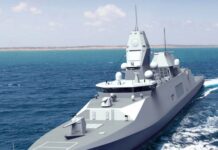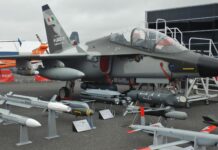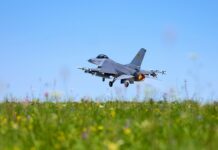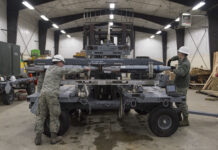Staying in contact at individual soldier level on today’s battlefield is hard at the best of times, but some environs present tougher conditions for effective radio communications than others. This is why US and UK forces are now adopting some of the same soldier radios and have been assessing their new systems in extreme jungle conditions.
Towards the end of 2022, the UK MoD announced a contract worth GBP 90 M signed with L3 Harris for 1,300 Falcon IV AN/PRC-163 handheld radios to upgrade land-based radio capabilities. The new radios are set to support ground-to-ground and ground-to-air communications and improve overall battlefield effectiveness down to individual soldier level.
The handheld Falcon IV AN/PRC-163 is a multi-mode radio (MMR) designed for use by infantry, dismounted or mounted, and will help meet the UK’s MMR requirement. UK Defence Procurement Minister Alex Chalk stated that the radios would replace legacy systems and “boosts [the UK’s] interoperability with allies”. These sentiments were echoed by L3Harris, which said the new radios would enable UK land forces to communicate and interoperate with NATO and US allies using a solution that can be adapted for differing deployments and operational requirements. In February 2023, as British signallers were deployed to Belize to put the new radios to the test, L3Harris added that the tactical radio order actually comprised not only the AN/PRC-163 multi-channel handhelds, but also the AN/PRC-167 multi-channel software-defined radio (SDR) manpacks. This follows years of work by the UK towards procuring new MMR radios to improve land-based tactical communications. Keith Norton, Vice President and Managing Director, L3Harris Communications Systems UK, said the “tried-and-tested radios will make for speedier deployments, faster decision-making, and improved soldier safety.”

Credit: L3 Harris
The introduction of the two-channel L3Harris MMR radios into the UK Armed Forces’ tactical networks will provide greater flexibility in its communication options, plus access to a large library of resilient waveforms, as well as enhanced resilience against adversarial electronic attacks for deployed allied forces. In this regard, it is worth mentioning that several thousand of the latest SDRs, of one kind or another, have been supplied to the Ukrainian Armed Forces by L3Harris and have proven very effective operating even in highly degraded radiofrequency-compromised environments under ‘attack’ by Russian electronic warfare (EW) systems.
A New UK Handheld
Equipped with industry-leading mobile ad-hoc network (MANET) technologies, including TSM-X, ANW2 and others, the L3Harris Falcon IV AN/PRC-163 multi-channel handheld radio delivers dual-channel cross-banding capabilities in a single radio optimised for SWaP (size, weight and power) that supports seamless and simultaneous networking for over 200 users. Mission-critical information at a is displayed on the radio’s LCD screen. Moreover, situational awareness (SA) information is advanced through the intelligence, surveillance and reconnaissance (ISR) mission module’s full-motion video capabilities.
The Falcon IV AN/PRC-163 handheld is a software-defined radio, supporting simple updates to future waveforms and provides simultaneous voice and data over SATCOM/TACSAT, LOS and MANET modes, as well as fast, in-field updates as a tactical scenario evolves to offer new capabilities. Furthermore, an external mission-module, hardware interface enables users to quickly add options such as ISR video and satcom. The AN/PRC-163 with its battery it weighs just 1.25 kg (2.75 lbs), operates in temperatures from -30 °C to +55 °C (-22 °F to 140 °F) and can survive water immersion to depths of 20 m. It also provides secure network connections to computing devices, including Android smartphones. Its channel 1 standard waveforms are VHF/UHF LOS, ANW2 C, SINCGARS, P25, with optional waveforms including SATURN, HPW, IW Phase 1/2, HAVEQUICK I/II, SCM and e-BFT (DoD only). Its channel 2 waveforms are ANW2 C, UHF LOS, UHF SATCOM, with optional TSM-X, L-TAC, Wraith waveforms. Both channels have additional future waveform capabilities built in.
To the Test
Wasting little time after contract award by the MoD, UK airborne signallers from 216 (Parachute) Signal Squadron, Royal Corps of Signals, part of 16 Air Assault Brigade Combat Team, the British Army’s global response force, set off earlier this year to test the new radios in the jungles of Belize. This environment offered some of the most challenging of conditions for radio communications to work effectively, if at all. The squadron set out to test the full range of the AN/PRC-163’s capabilities on ‘Exercise Mercury Canopy’ where the damp, hot and humid conditions, together with dense and at times impenetrable vegetation, not only limits line-of-sight communications, but also attenuates radio waves like few other scenarios. Added to that is the hostile environment’s ways of trying its best to wreck both man and machine through water ingress, dirt, mud, insects, fungal growth, if soldiers fail to maintain rigorous care and cleaning disciplines. Over five weeks of manoeuvres, the signallers lived in the Belizean jungle for extended periods, learning how to look after themselves and their kit, adapting and incorporating their new communications systems within their soldiering skill routines so they and the radios could survive the demands of jungle extremes.

Credit: UK MoD/Cpl Danny Houghton
“As a signal squadron, we would normally deploy in support of other units, but Belize has been a fantastic and unique opportunity for us to focus on learning by doing,” said Maj. Liam Crane, Officer Commanding 216 in a British Army report. He added, “MMR is two radios in one. It provides line-of-sight voice and data over wideband radio between a unit on the ground, while simultaneously communicating anywhere in the world via satellite. The mesh networking capabilities mean that we can run applications, so troops out in the Belizean jungle and back at our headquarters in Colchester are working off the same information at the same time.”
The signallers found the new MMR equipment provided the necessary bandwidth in the jungle to handle the huge amounts of data involved in modern operations. They also found that while challenges presented themselves in the extreme conditions at many different junctures, the squadron was able to learn how to use the equipment in ways to get around any number of obstacles as they occurred. Overall, the British signallers said that the new MMR performed very well under those conditions and that while it had been a real challenge to learn how to use new Army equipment with new capabilities. They also noted that beyond its versatility, a key benefit of the MMR is the smaller and more energy-efficient package it comes in. “With water, rations and ammunition, soldiers can be carrying up to 60 kg. MMR fits in a webbing pouch where a Bowman radio can take up half of a daypack. Operating in the heat, humidity and tough terrain of the jungle, we’re really feeling the benefit of that reduced bulk,” added Maj. Crane.
Alongside the UK, the AN/PRC-163 radio has already been widely adopted by the US Army, US Marine Corps, US Special Operations Command, US Air Force, and a number of NATO Allies.
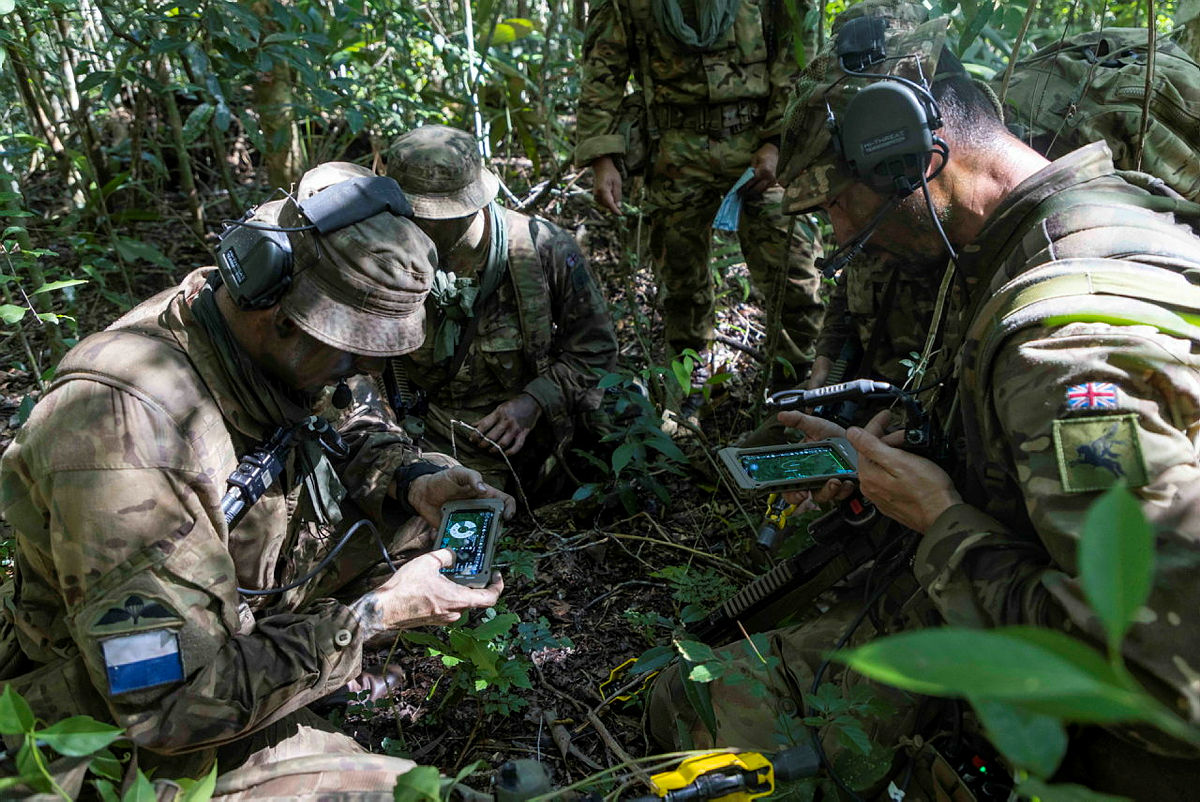
Credit: UK MoD/Cpl Danny Houghton
US Colleagues – Same Kit, Similar Extremes
Following new equipment fielding and training in the summer of 2021, some of those US Forces with the new radios included the 3rd Infantry Brigade Combat Team (IBCT), 25th Infantry Division (3/25 ID), which set out in August of that year to conduct ‘Exercise Bronco Rumble’. This was a company-level, air-assault exercise at the Kahuku Training Area on Oahu, Hawaii, designed to test the capabilities of the US Army’s integrated tactical network (ITN), including their new AN/PRC-163 MMRs and associated devices.
The ITN is a flexible, mobile network solution available down to dismounted soldiers that incorporates commercial solutions into existing tactical networks. Under the mountainous and jungle extremes of Hawaii, the aim of the exercise was for the brigade to test its ability to conduct operations over large distances, including between neighbouring islands, while still maintaining operational control. The 3/25 ID was the third IBCT to receive and evaluate the ITN and its component radios in order to provide feedback to the Army as part of its overall network modernisation strategy, much in the same way as the UK’s 216 (Parachute) Signal Squadron did in Belize.

Credit: US Army/Kathryn Bailey
Fielded at that time, the Capability Set 21 ITN included commercial single and two-channel radios, end-user cellular devices, the tactical radio integration kit box, which integrates the ITN’s radio variants to create a single battlefield network, in addition to small aperture satellite terminals, a variable height antenna, and various support technologies such as servers, gateways and cross-domain solutions. These capabilities were all housed in tactical operations centres, integrated into vehicles, or are part of a dismounted soldier’s kit.
At the heart of the ITN are its radios, including the manpack mobile user objective system (MUOS) tactical satellite radio and the Falcon IV AN/PRC-163. The MUOS boosts over-the-horizon tactical satellite (TACSAT) communication capabilities, not just upwards to brigade or battalion level, but now all the way down to company and individual troop level, which participants on the exercise in Hawaii said was ‘a game changer’. The manoeuvres tested possible scenarios between islands that mirrored what the US contemplates it might be faced with in a future Pacific conflict, with the communications holding up well. One platoon leader described the configuration of his ITN radio components, with a shadow radio used to talk among his platoon connected to his Falcon headset, his PRC/163 ‘leader radio’ also connected, that enables seamless communications with his platoon, as well as with higher headquarters, for such tasks as calling up fire support and medevac.
Ensuring a commander on the ground can talk to subordinate as well as higher commanders is an overarching aim of the system. The platoon leader added that the AN/PRC-163 leader radios also provide the signal to the ITN’s Android tactical assault kit (ATAK) hand-held end-user situational awareness device, used to display real-time Position Information Location (PLI). With little knowledge of the terrain, the assaulting force on Hawaii Island had to rely on the ATAK devices to establish PLI of friendly forces and SA of the jungle and open terrain. The AN/PRC-163s were also noted as being able to enhance soldiers’ primary, alternative, conting ency, emergency (PACE) plans, with the two-channel radio offering a back-up, secondary channel switch should the primary channel fail.

Credit: US Army/Staff Sgt Alan Brutus
When it came to logistics support during the exercise, the ITN’s SA capabilities through use of its ATAK handheld devices was a major boost to support and track critical convoys, supplies and medevac missions. Integrated and bolstered by the beyond-line-of-site capabilities of the MUOS, ATAK was crucial in extending lines of communication, ensuring logistics flow and aiding individual soldier safety.
That many of the ITN’s elements are entering service with several allied forces beyond just the US and UKbodes well for allied interoperability and joint capabilities in an increasingly threatening climate of peer-to-peer aggression.
Austria Opts for SquadNet
In late-March 2023, Austria awarded Thales a contract for the provision over 2,500 SquadNet tactical radios to support the Austrian Army’s digital transformation. This is the second significant European order for this radio after Belgium and strengthens the product’s position on the soldier radio market in Europe. According to Thales, SquadNet combines a unique networking waveform with built-in GPS, Bluetooth and programmable encryption to provide reliable, secure critical communications capabilities. Able to operate for 28 hours on a fully charged battery, this makes the radio highly suited for dismounted troops. It provides voice, location reporting and data-sharing options and is equipped with Thales’ SABRE battlefield software system, which allows users to view the location of all team members overlaid on a map, and allowing target data and other points of interest, including navigational information, to be communicated to each individual.

Credit: Thales
The SquadNet soldier radio is a rugged voice radio with advanced functionality for resilient infantry squad-level communication. Its features include a point-to-point/LOS range of up to 2.5 km; an automatic relay mode; blue-force tracking; SA; target, text and picture-sending capabilities; duplex, multiple voice nets and frequency hopping waveforms. It is available in 430-470 MHz and 865-880 MHz variants. GPS location data can be shared across a network bridge, or gateway, to provide a real-time command overview. For charging purposes, power can be drawn from USB-equipped power sources, such as laptops and portable solar panels, enabling personnel to scavenge power from multiple sources, wherever they find them. This, combined with the extended mission life of 28 hours provided by a rechargeable battery, reduces the need to carry spare batteries, thereby freeing up vital personal carriage space for ammunition, food and water.
With an automatic relaying mode and environment-resilient waveform, Thales says that the SquadNet soldier radio ensures communications can be maintained even in difficult propagation conditions, such as urban, wooded and mountainous terrain, thereby supporting effective collaborative combat on the battlefield.
Tim Guest






![Connect-4 The European Super RAP developed by NATO’s ACCS is shared with NATO’s Allied Air Command headquarters in Ramstein, western Germany. Two CAOCS, controlling NATO airspace above northern and southern Europe, generate these RAPs. [NATO]](https://euro-sd.com/wp-content/uploads/2025/06/NATO-Allied-Air-Command-NATO-Kopie-218x150.jpg)

